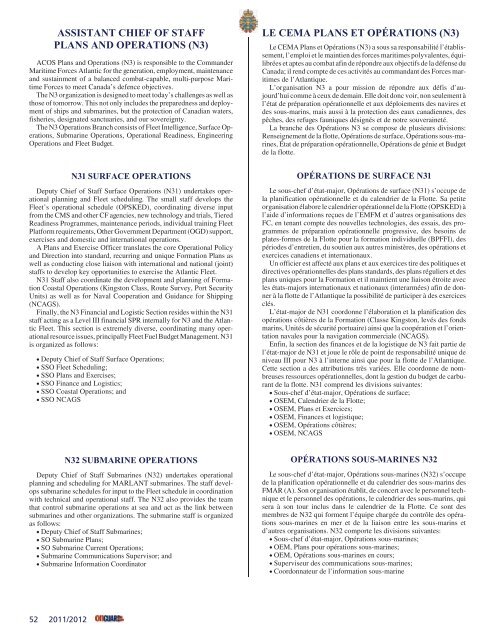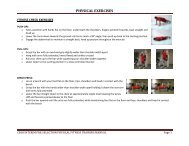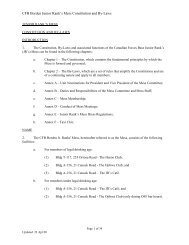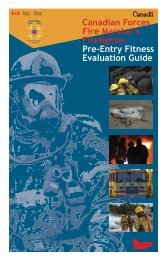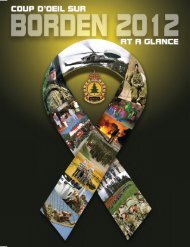We Care!
We Care!
We Care!
You also want an ePaper? Increase the reach of your titles
YUMPU automatically turns print PDFs into web optimized ePapers that Google loves.
ASSISTANT CHIEF OF STAFF<br />
PLANS AND OPERATIONS (N3)<br />
ACOS Plans and Operations (N3) is responsible to the Commander<br />
Maritime Forces Atlantic for the generation, employment, maintenance<br />
and sustainment of a balanced combat-capable, multi-purpose Maritime<br />
Forces to meet Canada’s defence objectives.<br />
The N3 organization is designed to meet today’s challenges as well as<br />
those of tomorrow. This not only includes the preparedness and deployment<br />
of ships and submarines, but the protection of Canadian waters,<br />
fisheries, designated sanctuaries, and our sovereignty.<br />
The N3 Operations Branch consists of Fleet Intelligence, Surface Operations,<br />
Submarine Operations, Operational Readiness, Engineering<br />
Operations and Fleet Budget.<br />
Deputy Chief of Staff Surface Operations (N31) undertakes operational<br />
planning and Fleet scheduling. The small staff develops the<br />
Fleet’s operational schedule (OPSKED), coordinating diverse input<br />
from the CMS and other CF agencies, new technology and trials, Tiered<br />
Readiness Programmes, maintenance periods, individual training Fleet<br />
Platform requirements, Other Government Department (OGD) support,<br />
exercises and domestic and international operations.<br />
A Plans and Exercise Officer translates the core Operational Policy<br />
and Direction into standard, recurring and unique Formation Plans as<br />
well as conducting close liaison with international and national (joint)<br />
staffs to develop key opportunities to exercise the Atlantic Fleet.<br />
N31 Staff also coordinate the development and planning of Formation<br />
Coastal Operations (Kingston Class, Route Survey, Port Security<br />
Units) as well as for Naval Cooperation and Guidance for Shipping<br />
(NCAGS).<br />
Finally, the N3 Financial and Logistic Section resides within the N31<br />
staff acting as a Level III financial SPR internally for N3 and the Atlantic<br />
Fleet. This section is extremely diverse, coordinating many operational<br />
resource issues, principally Fleet Fuel Budget Management. N31<br />
is organized as follows:<br />
• Deputy Chief of Staff Surface Operations;<br />
• SSO Fleet Scheduling;<br />
• SSO Plans and Exercises;<br />
• SSO Finance and Logistics;<br />
• SSO Coastal Operations; and<br />
• SSO NCAGS<br />
52 2011/2012<br />
N31 SURFACE OPERATIONS<br />
N32 SUBMARINE OPERATIONS<br />
Deputy Chief of Staff Submarines (N32) undertakes operational<br />
planning and scheduling for MARLANT submarines. The staff develops<br />
submarine schedules for input to the Fleet schedule in coordination<br />
with technical and operational staff. The N32 also provides the team<br />
that control submarine operations at sea and act as the link between<br />
submarines and other organizations. The submarine staff is organized<br />
as follows:<br />
• Deputy Chief of Staff Submarines;<br />
• SO Submarine Plans;<br />
• SO Submarine Current Operations;<br />
• Submarine Communications Supervisor; and<br />
• Submarine Information Coordinator<br />
LE CEMA PLANS ET OPÉRATIONS (N3)<br />
Le CEMA Plans et Opérations (N3) a sous sa responsabilité l’établissement,<br />
l’emploi et le maintien des forces maritimes polyvalentes, équilibrées<br />
et aptes au combat afin de répondre aux objectifs de la défense du<br />
Canada; il rend compte de ces activités au commandant des Forces maritimes<br />
de l’Atlantique.<br />
L’organisation N3 a pour mission de répondre aux défis d’aujourd’hui<br />
comme à ceux de demain. Elle doit donc voir, non seulement à<br />
l’état de préparation opérationnelle et aux déploiements des navires et<br />
des sous-marins, mais aussi à la protection des eaux canadiennes, des<br />
pêches, des refuges fauniques désignés et de notre souveraineté.<br />
La branche des Opérations N3 se compose de plusieurs divisions:<br />
Renseignement de la flotte, Opérations de surface, Opérations sous-marines,<br />
État de préparation opérationnelle, Opérations de génie et Budget<br />
de la flotte.<br />
OPÉRATIONS DE SURFACE N31<br />
Le sous-chef d’état-major, Opérations de surface (N31) s’occupe de<br />
la planification opérationnelle et du calendrier de la Flotte. Sa petite<br />
organisation élabore le calendrier opérationnel de la Flotte (OPSKED) à<br />
l’aide d’informations reçues de l’EMFM et d’autres organisations des<br />
FC, en tenant compte des nouvelles technologies, des essais, des programmes<br />
de préparation opérationnelle progressive, des besoins de<br />
plates-formes de la Flotte pour la formation individuelle (BPFFI), des<br />
périodes d’entretien, du soutien aux autres ministères, des opérations et<br />
exercices canadiens et internationaux.<br />
Un officier est affecté aux plans et aux exercices tire des politiques et<br />
directives opérationnelles des plans standards, des plans réguliers et des<br />
plans uniques pour la Formation et il maintient une liaison étroite avec<br />
les états-majors internationaux et nationaux (interarmées) afin de donner<br />
à la flotte de l’Atlantique la possibilité de participer à des exercices<br />
clés.<br />
L’état-major de N31 coordonne l’élaboration et la planification des<br />
opérations côtières de la Formation (Classe Kingston, levés des fonds<br />
marins, Unités de sécurité portuaire) ainsi que la coopération et l’orientation<br />
navales pour la navigation commerciale (NCAGS).<br />
Enfin, la section des finances et de la logistique de N3 fait partie de<br />
l’état-major de N31 et joue le rôle de point de responsabilité unique de<br />
niveau III pour N3 à l’interne ainsi que pour la flotte de l’Atlantique.<br />
Cette section a des attributions très variées. Elle coordonne de nombreuses<br />
ressources opérationnelles, dont la gestion du budget de carburant<br />
de la flotte. N31 comprend les divisions suivantes:<br />
• Sous-chef d’état-major, Opérations de surface;<br />
• OSEM, Calendrier de la Flotte;<br />
• OSEM, Plans et Exercices;<br />
• OSEM, Finances et logistique;<br />
• OSEM, Opérations côtières;<br />
• OSEM, NCAGS<br />
OPÉRATIONS SOUS-MARINES N32<br />
Le sous-chef d’état-major, Opérations sous-marines (N32) s’occupe<br />
de la planification opérationnelle et du calendrier des sous-marins des<br />
FMAR (A). Son organisation établit, de concert avec le personnel technique<br />
et le personnel des opérations, le calendrier des sous-marins, qui<br />
sera à son tour inclus dans le calendrier de la Flotte. Ce sont des<br />
membres de N32 qui forment l’équipe chargée du contrôle des opérations<br />
sous-marines en mer et de la liaison entre les sous-marins et<br />
d’autres organisations. N32 comporte les divisions suivantes:<br />
• Sous-chef d’état-major, Opérations sous-marines;<br />
• OEM, Plans pour opérations sous-marines;<br />
• OEM, Opérations sous-marines en cours;<br />
• Superviseur des communications sous-marines;<br />
• Coordonnateur de l’information sous-marine


